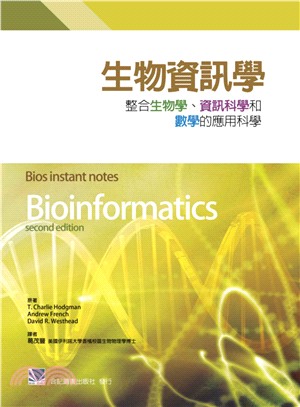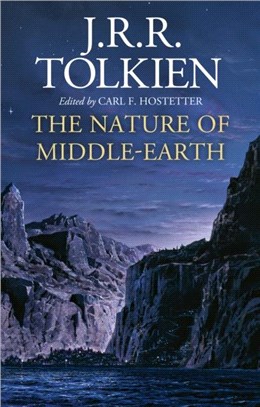生物資訊學:整合生物學、資訊科學和數學的應用科學
商品資訊
ISBN13:9789863680055
出版社:合記經銷(香港)
作者:T. Charlie Hodgman; Andrew French; David R‧Westhead
譯者:葛茂豐
出版日:2014/08/01
裝訂/頁數:平裝/352頁
規格:26cm*19cm*1.5cm (高/寬/厚)
版次:1
商品簡介
序
目次
相關商品
商品簡介
「生物資訊學」是一新興的研究領域,不僅能應用在分子生物學上的研究,同時也可運用在大多數生命科學的領域。本書內容分為三大部分:第一部分為概述生物資訊學及其生物研究的應用;第二部分涵蓋資訊學的基礎知識,包括物理、數學、統計和計算,並附上生物學的實例;第三部分則是介紹生物學應用的三個次領域,包含分子生物學、代謝、解剖等。內容貫穿基礎知識和應用領域,編排上彼此呼應以呈現其關聯性,使讀者在學習時更能環環相扣、觸類旁通,從中了解基礎知識與應用領域之間的脈絡。為生物、化學、醫學和神經科學等不同領域的學生,提供生物資訊學的基礎教材。
序
自從Instant Notes in Bioinformatics(1e)出版後,此領域已大幅進展,逐步建立為一門獨立的學科,因此很感謝出版社給我們這個機會出版本書第二版。我們將本書結構稍作調整,目標有二:第一、不論學生背景為何─生物、化學、醫學還是神經科學…等,本書都能作為學習教材。第二、讓大家知道,這些常見的資訊學方法,不只能應用在生物資訊學蓬勃發展的分子生物學領域,也能應用在大多數生命科學的研究領域。
本書章節分為三大部分,第一部分(第1、2章)為本學科的導論。第一章概述為何生物資訊學逐漸成為不可或缺的研究方法。第二章則藉由一連串生物資訊學的定義,簡短介紹這門學科的歷史,從 1960 年代的起步,到 1980 年代的振奮人心(如果不算是讓人如癡如醉的話),再到二十一世紀,生物資訊學已應用在各式各樣的生物資料上。
第二部分包括本學科的基礎知識(第3章到第9章):物理、數學和資訊科學。不過這裡省略了一個重要項目─程式設計,它對生物資訊學研究非常重要,但因為篇幅的限制,在此無法提供任何程式語言的適當訓練。程式設計是非常實用的技能,留給其他許多市面上的書籍作介紹。不過在此我們還是試著簡述,良好資料管理和程式設計的基本原理。
第三部分則是應用的生物學領域(第10章到第18章),再細分為三個部分:(一)分子生物學;(二)代謝、解剖和生理;以及(三)複雜的原始資料(特別是影像資料集合和自然語言文本),其中文本分析是資料最難以準確擷取、量化的研究領域。本書第二和第三部分的相互關係如前一頁的圖,此圖特別強調基礎知識的重要性,因為從兩者間如此緊密交纏的網狀結構可清楚看出,所有應用領域皆奠基於這些基礎知識。
現在生物資訊學的涵蓋範圍極廣,因此本書三位主要作者認為,應該邀請其他人編寫某些章節。我們在此向其他幾位作者的貢獻致上感謝之意:第10章(Nicola Gold)、第11章(Alex Marshall)、第12章(Nicola Gold & Tom Gallagher)以及第13章(Rob Linforth)。有些人則幫忙核對某幾個章節,讓內容更準確清楚,在此感謝 Alastair Middleton、Leah Band、Tom Gallagher 和 Kim Kenobi 的協助,尤其是感謝 Jane Hodgman(同時也校對許多章節)。我們也一併致謝植物整合生物學英國中心(UK Center for Plant Integrative Biology)的成員們,在出版前提供許多顯微影像。讀者也許會發現一些重複之處,不過為了內容的清楚,還是保留這些重複。最後,我們希望學生和教師們都能夠領會這門學科的廣博,同時也喜愛這本書。
本書章節分為三大部分,第一部分(第1、2章)為本學科的導論。第一章概述為何生物資訊學逐漸成為不可或缺的研究方法。第二章則藉由一連串生物資訊學的定義,簡短介紹這門學科的歷史,從 1960 年代的起步,到 1980 年代的振奮人心(如果不算是讓人如癡如醉的話),再到二十一世紀,生物資訊學已應用在各式各樣的生物資料上。
第二部分包括本學科的基礎知識(第3章到第9章):物理、數學和資訊科學。不過這裡省略了一個重要項目─程式設計,它對生物資訊學研究非常重要,但因為篇幅的限制,在此無法提供任何程式語言的適當訓練。程式設計是非常實用的技能,留給其他許多市面上的書籍作介紹。不過在此我們還是試著簡述,良好資料管理和程式設計的基本原理。
第三部分則是應用的生物學領域(第10章到第18章),再細分為三個部分:(一)分子生物學;(二)代謝、解剖和生理;以及(三)複雜的原始資料(特別是影像資料集合和自然語言文本),其中文本分析是資料最難以準確擷取、量化的研究領域。本書第二和第三部分的相互關係如前一頁的圖,此圖特別強調基礎知識的重要性,因為從兩者間如此緊密交纏的網狀結構可清楚看出,所有應用領域皆奠基於這些基礎知識。
現在生物資訊學的涵蓋範圍極廣,因此本書三位主要作者認為,應該邀請其他人編寫某些章節。我們在此向其他幾位作者的貢獻致上感謝之意:第10章(Nicola Gold)、第11章(Alex Marshall)、第12章(Nicola Gold & Tom Gallagher)以及第13章(Rob Linforth)。有些人則幫忙核對某幾個章節,讓內容更準確清楚,在此感謝 Alastair Middleton、Leah Band、Tom Gallagher 和 Kim Kenobi 的協助,尤其是感謝 Jane Hodgman(同時也校對許多章節)。我們也一併致謝植物整合生物學英國中心(UK Center for Plant Integrative Biology)的成員們,在出版前提供許多顯微影像。讀者也許會發現一些重複之處,不過為了內容的清楚,還是保留這些重複。最後,我們希望學生和教師們都能夠領會這門學科的廣博,同時也喜愛這本書。
目次
縮寫表(Abbreviations) vi
前言(Preface) viii
第 1 章 日新又新的生物學研究(The changing face of research biology) 1
第 2 章 生物資訊學定義(Definitions of bioinformatics) 7
第 3 章 基本物理學(Essentials of physics) 13
第 4 章 資料與資料庫(Data and databases) 19
第 5 章 資料類別(Data categories) 29
5-1 資料類別(Data categories) 29
5-2 生物資訊學資料表示法最佳實務 34
(Best practice for data representation in bioinformatics)
第 6 章 計算(Computation) 37
第 7 章 機率與統計(Probability and statistics) 49
7-1 機率與機率分佈(Probability and probability distributions) 49
7-2 條件機率與貝氏定理(Conditional probability and Bayes?rule) 56
7-3 基礎統計檢定(Elementary statistical testing) 61
第 8 章 建模與數學方法(Modeling and mathematical techniques) 69
8-1 系統屬性(System features) 69
8-2 圖形理論及其應用(Graph theory and its applications) 72
8-3 常微分方程與代數學(Ordinary differential equations and algebra) 79
8-4 高等建模方法(Advanced modeling techniques) 83
8-5 形狀、變形與生長(Shape, deformation and growth) 86
第 9 章 人工智慧與機器學習(Artificial intelligence and machine learning) 89
9-1 人工智慧與機器學習導論(Introduction to artificial intelligence and machine learning) 89
9-2 人工智慧與機器學習的統計方法 91
(Statistical approaches to artificial intelligence and machine learning)
9-3 人工智慧與機器學習的計算方法 99
(Computation approaches to artificial intelligence and machine learning)
第 10 章 基因體與其他序列(Genomes and other sequences) 107
10-1 資料庫與原始資料(Databases and data sources) 107
10-2 基因體註解(Genome annotation) 131
10-3 序列分析(Sequence analysis) 139
10-4 序列家族、比對與親緣關係(Sequence families, alignment and phylogeny) 160
10-5 域家族與資料庫(Domain families and databases) 173
第 11 章 轉錄體學(Transcriptomics) 181
11-1 轉錄產物特性分析(Transcript profiling) 181
11-2 轉錄體分析的統計問題(Statistical issues for transcriptome analysis) 185
11-3 解析基因表現程度差異(Analyzing differential gene expression) 187
11-4 多變量方法與網路推論(Multivariate techniques and network inference) 194
11-5 資料標準與實驗設計(Data standards and experimental design) 199
第 12 章 蛋白質與蛋白質體學(Proteins and Proteomics) 203
12-1 蛋白質體學方法(Proteomics techniques) 203
12-2 交互作用蛋白質體學(Interaction proteomics) 213
12-3 交互作用資料庫與網路(Interaction databases and networks) 217
12-4 結構生物資訊學(Structural bioinformatics) 221
12-5 結構分類(Structural classifications) 241
12-6 結構預測與建模(Structure prediction and modeling) 245
12-7 分子動力學與藥物設計(Molecular dynamics and drug design) 259
第 13 章 代謝體學(Metabolomics) 267
第 14 章 超分子結構(Supramolecular organization) 271
14-1 超分子結構(Supramolecular organization) 271
14-2 組織等級與生物體等級的結構(Tissue- and organism-scale organization) 273
第 15 章 生化動力學(Biochemical dynamics) 275
15-1 代謝的網路研究(Network studies of metabolism) 275
15-2 微積分與代數的使用(Use of calculus and algebra) 273
第 16 章 生理學(Physiology) 289
16-1 生理學(Physiology) 289
16-2 整合生物學與植物建模(Integrative biology and plant modeling) 293
16-3 整合生物學 ─ 結論(Integrative biology – conclusions) 296
第 17 章 影像分析(Image analysis) 299
17-1 什麼是影像分析?(What is image analysis?) 299
17-2 影像分析如何應用於生物科學研究? 304
(How is image analysis used in bioscience research?)
17-3 影像增強(Image enhancement) 311
17-4 特徵檢測(Feature detection) 315
17-5 資料擷取(Data extraction) 319
第 18 章 文本分析(Textual analysis) 323
延伸閱讀(Further reading) 329
索引(Index) 337
前言(Preface) viii
第 1 章 日新又新的生物學研究(The changing face of research biology) 1
第 2 章 生物資訊學定義(Definitions of bioinformatics) 7
第 3 章 基本物理學(Essentials of physics) 13
第 4 章 資料與資料庫(Data and databases) 19
第 5 章 資料類別(Data categories) 29
5-1 資料類別(Data categories) 29
5-2 生物資訊學資料表示法最佳實務 34
(Best practice for data representation in bioinformatics)
第 6 章 計算(Computation) 37
第 7 章 機率與統計(Probability and statistics) 49
7-1 機率與機率分佈(Probability and probability distributions) 49
7-2 條件機率與貝氏定理(Conditional probability and Bayes?rule) 56
7-3 基礎統計檢定(Elementary statistical testing) 61
第 8 章 建模與數學方法(Modeling and mathematical techniques) 69
8-1 系統屬性(System features) 69
8-2 圖形理論及其應用(Graph theory and its applications) 72
8-3 常微分方程與代數學(Ordinary differential equations and algebra) 79
8-4 高等建模方法(Advanced modeling techniques) 83
8-5 形狀、變形與生長(Shape, deformation and growth) 86
第 9 章 人工智慧與機器學習(Artificial intelligence and machine learning) 89
9-1 人工智慧與機器學習導論(Introduction to artificial intelligence and machine learning) 89
9-2 人工智慧與機器學習的統計方法 91
(Statistical approaches to artificial intelligence and machine learning)
9-3 人工智慧與機器學習的計算方法 99
(Computation approaches to artificial intelligence and machine learning)
第 10 章 基因體與其他序列(Genomes and other sequences) 107
10-1 資料庫與原始資料(Databases and data sources) 107
10-2 基因體註解(Genome annotation) 131
10-3 序列分析(Sequence analysis) 139
10-4 序列家族、比對與親緣關係(Sequence families, alignment and phylogeny) 160
10-5 域家族與資料庫(Domain families and databases) 173
第 11 章 轉錄體學(Transcriptomics) 181
11-1 轉錄產物特性分析(Transcript profiling) 181
11-2 轉錄體分析的統計問題(Statistical issues for transcriptome analysis) 185
11-3 解析基因表現程度差異(Analyzing differential gene expression) 187
11-4 多變量方法與網路推論(Multivariate techniques and network inference) 194
11-5 資料標準與實驗設計(Data standards and experimental design) 199
第 12 章 蛋白質與蛋白質體學(Proteins and Proteomics) 203
12-1 蛋白質體學方法(Proteomics techniques) 203
12-2 交互作用蛋白質體學(Interaction proteomics) 213
12-3 交互作用資料庫與網路(Interaction databases and networks) 217
12-4 結構生物資訊學(Structural bioinformatics) 221
12-5 結構分類(Structural classifications) 241
12-6 結構預測與建模(Structure prediction and modeling) 245
12-7 分子動力學與藥物設計(Molecular dynamics and drug design) 259
第 13 章 代謝體學(Metabolomics) 267
第 14 章 超分子結構(Supramolecular organization) 271
14-1 超分子結構(Supramolecular organization) 271
14-2 組織等級與生物體等級的結構(Tissue- and organism-scale organization) 273
第 15 章 生化動力學(Biochemical dynamics) 275
15-1 代謝的網路研究(Network studies of metabolism) 275
15-2 微積分與代數的使用(Use of calculus and algebra) 273
第 16 章 生理學(Physiology) 289
16-1 生理學(Physiology) 289
16-2 整合生物學與植物建模(Integrative biology and plant modeling) 293
16-3 整合生物學 ─ 結論(Integrative biology – conclusions) 296
第 17 章 影像分析(Image analysis) 299
17-1 什麼是影像分析?(What is image analysis?) 299
17-2 影像分析如何應用於生物科學研究? 304
(How is image analysis used in bioscience research?)
17-3 影像增強(Image enhancement) 311
17-4 特徵檢測(Feature detection) 315
17-5 資料擷取(Data extraction) 319
第 18 章 文本分析(Textual analysis) 323
延伸閱讀(Further reading) 329
索引(Index) 337
主題書展
更多
主題書展
更多書展今日66折
您曾經瀏覽過的商品
購物須知
為了保護您的權益,「三民網路書店」提供會員七日商品鑑賞期(收到商品為起始日)。
若要辦理退貨,請在商品鑑賞期內寄回,且商品必須是全新狀態與完整包裝(商品、附件、發票、隨貨贈品等)否則恕不接受退貨。
























